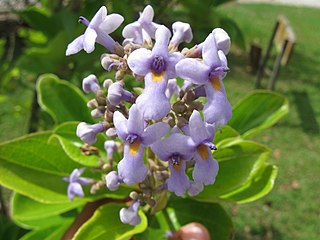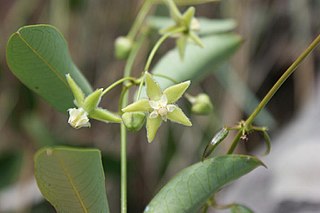
Zamia is a genus of cycad of the family Zamiaceae, native to North America from the United States throughout the West Indies, Central America, and South America as far south as Bolivia. The genus is considered to be the most ecologically and morphologically diverse of the cycads, and is estimated to have originated about 68.3 million years ago.
Enriquebeltrania crenatifolia is a plant species of the family Euphorbiaceae endemic to the Yucatán Peninsula in southeastern Mexico.
Bernardia is a plant genus of the family Euphorbiaceae first described for modern science as a genus in 1754. It is native to North and South America, as well as the West Indies.

Caperonia is a genus of plants of the family Euphorbiaceae first described as a genus in 1825. The genus is native to tropical and subtropical America and Africa.
Ophellantha is a genus of plants under the family Euphorbiaceae first described as a genus in 1924. It is native to southern Mexico and northern Central America.
- Ophellantha spinosaStandl. - Honduras, El Salvador, Chiapas, Veracruz
- Ophellantha steyermarkiiStandl. - Guatemala, Chiapas
Astrocasia is a plant genus of the family Phyllanthaceae first described as a genus in 1905. It is included in the subtribe Astrocasiinae. It is native to Mesoamerica, northern South America, and the western part of the West Indies. Plants are mostly dioecious, except for Astrocasia diegoae which is monoecious, and some individuals of A. neurocarpa and A. tremula.
- Astrocasia austinii(Standl.) G.L.Webster - Izabal
- Astrocasia diegoaeJ.Jiménez Ram. & Mart.Gord. - Guerrero
- Astrocasia jacobinensis(Müll.Arg.) G.L.Webster - Bahia, Bolivia
- Astrocasia neurocarpa(Müll.Arg.) I.M.Johnst. ex Standl. - Oaxaca, Querétaro, San Luis Potosí, Tamaulipas
- Astrocasia peltataStandl. - Costa Rica, Nayarit, Jalisco
- Astrocasia tremula (Griseb.) G.L.Webster - Mexico, Central America, West Indies, northern South America
Garcia nutans is a species of plant in the family Euphorbiaceae. It is widespread across Mexico from Sinaloa and San Luis Potosí to Chiapas + Yucatán, as well as being native to Central America, Colombia, and Venezuela.

Brassia maculata, the spotted brassia, is a species of orchid. It is native to southern Mexico, Central America, Cuba, and Jamaica.

Jouvea is a Latin American genus of coastal plants in the grass family. It grows on mud flats and coastal sand dunes from northern Mexico to Ecuador.
Goldmanella is a genus of flowering plants in the daisy family.
Spiracantha is a genus of flowering plants in the tribe Vernonieae within the family Asteraceae.

Androlepis skinneri is a plant species native to southern Mexico and Central America. This is one of the few Bromelioideae species that is dioecious.

Tillandsia bulbosa, the bulbous airplant, is a species of flowering plant in the genus Tillandsia. It is widespread across Central America, the West Indies, southern Mexico, and northern and eastern South America.
Greigia vanhyningii is a plant species in the genus Greigia. This species is endemic to southern Mexico.

Sarcoglottis is a genus of flowering plants from the orchid family, Orchidaceae. It is widespread across much of Latin America from Mexico to Argentina, with one species extending northward into Trinidad and the Windward Islands.

Ionopsis utricularioides, the delicate violet orchid, is an epiphytic orchid native to the warmer parts of the Americas. It is reported from Florida, Mexico, Central America, much of the West Indies including the Cayman Islands, South America as far south as Paraguay, and the Galápagos.

Cornutia is a genus of plants in the family Lamiaceae, first described in 1753. Species in this genus are native to tropical parts of the Western Hemisphere, including southern Mexico, Central America, the West Indies, and northern South America.

Blepharodon is a genus of plant in the family Apocynaceae, first described as a genus in 1844. They are native primarily to South America, with one species extending into Central America and Mexico.
Cirsium mexicanum is a Mesoamerican and Caribbean species of plants in the tribe Cardueae within the family Asteraceae. Common name is Mexican thistle. It is widespread across Mexico, Central America and the West Indies.
Xyris ambigua, the coastal plain yelloweyed grass, is a North American species of flowering plant in the yellow-eyed-grass family. It is native to southern and eastern Mexico, Central America, Cuba, and the southeastern and south-central United States.










